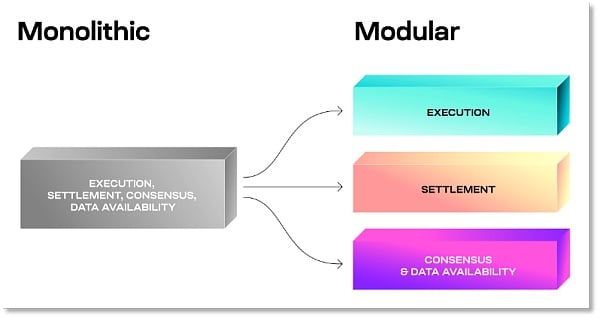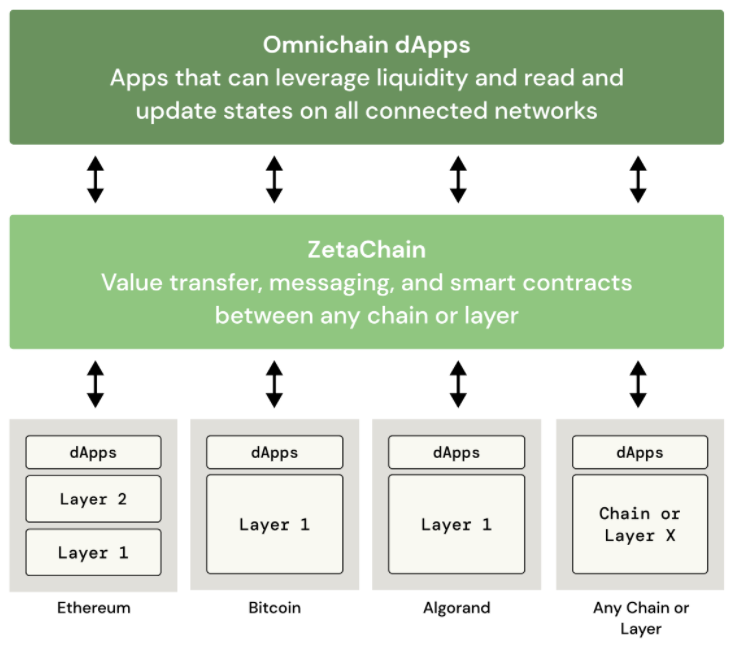سعر ZetaChain (ZETA)
سعر ZetaChain (ZETA) اليوم
بيانات سوق ZetaChain (ZETA)
نبذة عن ZetaChain (ZETA)
كيف يمكنني شراء ZetaChain (ZETA)؟
ZetaChain will be the 5th largest public chain in 2024, with enormous potential
In Celestia's price analysis, it is explained that there will be significant changes in the market cap rankings of public chains in 2024. The rankings will be in the following order: BTC ETH SOL TIA. Zetachain's token ZETA will become the 5th largest public chain. The competition among blockchain public chains in 2024 has reached a fever pitch.
Competition is about the core competitiveness of the product. In the first round of public chain competition, it was mainly a competition between POW and POS. In the second round, it was mainly a competition of TPS and transaction fees. The third round of public chain competition is about the developer experience. So, whoever can attract the most developers will be the winner in the 2024 public chain space.
In the third round of public chain competition, there are mainly two major directions: 1. Modular blockchains 2. Multi-chain interoperability.
Modular blockchains: Ethereum divided the blockchain into execution layer, settlement layer, and DA layer, allowing developers to quickly create dApps using various modules. The advantage lies in the speed of development. Public chains can form alliances through modularization, concentrating resources. There will be competition among these public chain alliances, such as the competition between Celestia and Ethereum.

Multi-chain interoperability: Also known as chain abstraction: Deploying a dApp that can interact with multiple public chains. The advantage lies in the scale of dApps. For example, using multi-chain operations, you can transfer Bitcoin on multiple chains. Zeta is a Layer 1 public chain for multi-chain interoperability and is the largest one for multi-chain interoperability.

Multi-chain interoperability has undergone two transformations. The first generation is called Bridge, mainly to solve the problem of asset cross-chain transfer. For example, to transfer Bitcoin to Ethereum, you need to deposit Bitcoin into a Bridge service provider, and then Ethereum will create an eBTC token, which is not native. Once the Bridge is compromised, the stored BTC is lost.
The second generation is the LayerZero protocol. LayerZero is not a public chain but a protocol. Different public chains on both sides need to support the LayerZero protocol first, and the gas fee settlement for LayerZero is still on Ethereum.
The third generation is ZetaChain with chain abstraction. Zetachain is a fully smart contract-enabled public chain. Smart contracts deployed on Zetachain can interact with smart contracts on other public chains supported by Zetachain. Assets, including Bitcoin, can be transferred across multiple public chains using Zetachain's ZRC-20 protocol. Zetachain itself does not store any transferred assets; the parties in the transaction hold native tokens. It's similar to trading different tokens on a centralized exchange. There are no slippage issues, and hackers cannot access transaction assets. The biggest beneficiaries are DEX and DeFi, as well as developers of large dApps.
So, modular blockchains are very suitable for rapidly deploying small dApps, like building a two-story house with LEGO bricks. Chain abstraction, on the other hand, provides the resources needed for contractors to build a skyscraper.
Modular blockchains will intensify the competition among public chain alliances. Ethereum and Celestia are in direct competition. Chain abstraction gathers various public chains into a unified information and resource network, allowing developers to choose freely.
Therefore, Zeta and Celestia follow different development directions in the public chain space, each with its own advantages, all aimed at solving the problems faced by developers. The previous two generations of public chains focused on improving infrastructure.
Zetachain's Investment Background and Token Economy
Zetachain has a strong investment background, with participation from several well-known institutions in addition to Coinbase. The total investment is $27 million.
Zetachain's token Zeta has a total supply of 2.1 billion, with institutions receiving 16% of the tokens, which will start unlocking after 6 months and fully unlock in 2 years.
Community Airdrop (10%): 4.5% unlocked when the token goes live, and then 0.2% unlocked each month for the first 5 months. Starting 6 months after release, the remaining tokens will unlock linearly over 36 months.
Foundation (12%): 1.5% unlocked when the token goes live, and then the remaining tokens will unlock linearly over 32 months.
Validator Rewards (10%)
Liquidity and Staking Incentives (4%)
Protocol Treasury (24%): 2% unlocked when the token goes live, and then the remaining tokens will unlock linearly over 36 months.
Core Contributors (22.5%): Unlocking starts 6 months after the token goes live, with 1/18 unlocked each month for 6 months. After 12 months, the remaining 1/36 unlocks and continues for 24 months.
Zeta token is currently listed on multiple exchanges including BingX and Coinbase
مصدر المعلومات
محوّل السعر لرمز ZetaChain (ZETA)
- ZETA إلى USD1 ZETA = $ 0.07
- ZETA إلى VND1 ZETA = ₫ 1,980.78
- ZETA إلى EUR1 ZETA = € 0.06
- ZETA إلى TWD1 ZETA = NT$ 2.36
- ZETA إلى IDR1 ZETA = Rp 1,252.30
- ZETA إلى PLN1 ZETA = zł 0.26
- ZETA إلى UZS1 ZETA = so'm 911.69
- ZETA إلى JPY1 ZETA = ¥ 11.64
- ZETA إلى RUB1 ZETA = ₽ 5.98
- ZETA إلى TRY1 ZETA = ₺ 3.21
- ZETA إلى THB1 ZETA = ฿ 2.36
- ZETA إلى UAH1 ZETA = ₴ 3.17
- ZETA إلى SAR1 ZETA = ر.س 0.28
